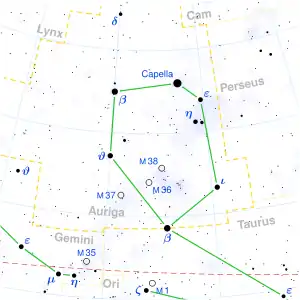HR 1884
HR 1884 is a spectroscopic binary star in the constellation Auriga. The primary is a G type supergiant star while the secondary is probably a B type main sequence star.[4]
| Observation data Epoch J2000.0 Equinox J2000.0 | |
|---|---|
| Constellation | Auriga |
| Right ascension | 05h 36m 52.417s[1] |
| Declination | +40° 10′ 56.55″[1] |
| Apparent magnitude (V) | 6.08[2] |
| Characteristics | |
| Spectral type | G3 Ib[3] + B7 V?[4] |
| U−B color index | 0.69[2] |
| B−V color index | 1.03[2] |
| Astrometry | |
| Radial velocity (Rv) | −12.06±0.03[4] km/s |
| Proper motion (μ) | RA: −2.99±1.03[1] mas/yr Dec.: −4.56±0.67[1] mas/yr |
| Parallax (π) | −0.75 ± 0.93[1] mas |
| Distance | 1,200[4] pc |
| Absolute magnitude (MV) | −2.79[5] |
| Orbit[4] | |
| Period (P) | 7829.3±1.4 days |
| Eccentricity (e) | 0.8867±0.0006 |
| Periastron epoch (T) | 54417.21±0.22 |
| Argument of periastron (ω) (secondary) | 250.61±0.20° |
| Semi-amplitude (K1) (primary) | 21.77±0.04 km/s |
| Details | |
| Surface gravity (log g) | 1.78[6] cgs |
| Temperature | 5,082[5] K |
| Metallicity [Fe/H] | +0.04[6] dex |
| Rotational velocity (v sin i) | 6.2[7] km/s |
| Other designations | |
| Database references | |
| SIMBAD | data |
The possible spectroscopic binary nature of the star was first noted in 1983 by Gilbert Burki and Michel Mayor in a paper on the rate of binaries among supergiant stars.[8] In the same year, William P. Bidelman noted that the stellar spectrum was composite indicating a companion star.[9] Confirmation of spectroscopic binary status and a preliminary orbit was published in 1998 by R. Paul Butler,[10] a much more accurate orbit was published in 2015 by Roger Griffin.[4]
References
- van Leeuwen, F. (2007). "Validation of the new Hipparcos reduction". Astronomy and Astrophysics. 474 (2): 653–664. arXiv:0708.1752. Bibcode:2007A&A...474..653V. doi:10.1051/0004-6361:20078357. Vizier catalog entry
- Argue, A. N. (1966). "UBV photometry of 550 F, G and K type stars". Monthly Notices of the Royal Astronomical Society. 133 (4): 175–493. Bibcode:1966MNRAS.133..475A. doi:10.1093/mnras/133.4.475.
- Bidelman, William P. (1957). "Spectral Classification of Stars Noted on Case Objective-Prism Plates. I". Publications of the Astronomical Society of the Pacific. 69 (407): 147–152. Bibcode:1957PASP...69..147B. doi:10.1086/127034.
- Griffin, R. F. (2015). "Spectroscopic binary orbits from photoelectric radial velocities. Paper 241: HR 1884, HD 174103, HD 182563, and HR 8442, with a note on zeta Cephei". The Observatory. 135: 71–95. Bibcode:2015Obs...135...71G.
- Kovtyukh, V. V.; Chekhonadskikh, F. A.; Luck, R. E.; Soubiran, C.; Yasinskaya, M. P.; Belik, S. I. (2010). "Accurate luminosities for F-G supergiants from FeII/FeI line depth ratios". Monthly Notices of the Royal Astronomical Society. 408 (3): 1568. Bibcode:2010MNRAS.408.1568K. doi:10.1111/j.1365-2966.2010.17217.x.
- Luck, R. Earle (2014). "Parameters and Abundances in Luminous Stars". The Astronomical Journal. 147 (6): 137. Bibcode:2014AJ....147..137L. doi:10.1088/0004-6256/147/6/137.
- De Medeiros, J. R.; Udry, S.; Burki, G.; Mayor, M. (2002). "A catalog of rotational and radial velocities for evolved stars. II. Ib supergiant stars". Astronomy and Astrophysics. 395: 97–98. Bibcode:2002A&A...395...97D. doi:10.1051/0004-6361:20021214.
- Burki, G.; Mayor, M. (1983). "Nineteen new spectroscopic binaries and the rate of binary stars among F-M supergiants". Astronomy and Astrophysics. 124 (2): 256–266. Bibcode:1983A&A...124..256B.
- Bidelman, W. P. (1983). "Objective-prism discoveries in the northern sky. I". Astronomical Journal. 88: 1182–1186. Bibcode:1983AJ.....88.1182B. doi:10.1086/113408.
- Butler, R. Paul (1998). "A Precision Velocity Study of Photometrically Stable Stars in the Cepheid Instability Strip". Astrophysical Journal. 494 (1): 342–365. Bibcode:1998ApJ...494..342B. CiteSeerX 10.1.1.37.7095. doi:10.1086/305195.
This article is issued from Wikipedia. The text is licensed under Creative Commons - Attribution - Sharealike. Additional terms may apply for the media files.

